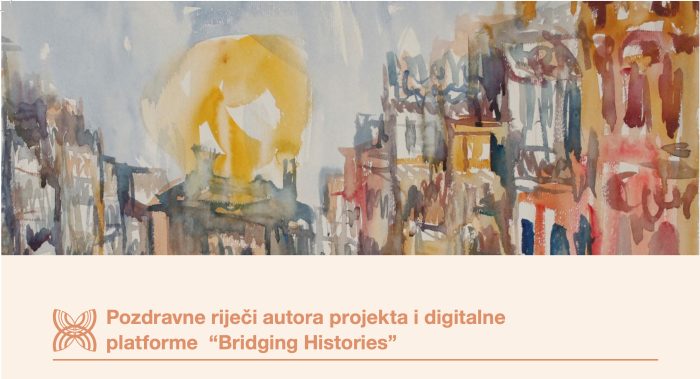A painter with a vivid imagination
Bridging Histories is delighted to join the National Gallery of Bosnia and Herzegovina, in celebrating the 100th anniversary of the birth of Dobrivoje Beljkašić, a groundbreaking painter and arts educator in Sarajevo, Bosnia.

Celebrating the great Dobrivoje Beljkašić
Year 2023 marks two important anniversaries for the cultural heritage of Bosnia and Herzegovina. It is the 31st anniversary of the destruction of Vijećnica, that housed the National Library, and the 100th anniversary of the birth of Dobrivoje Beljkašić, a renowned artist and proponent of visual art education. These two anniversaries are inextricably connected. Beljkašić’s studio, which was on the top floor of Vijećnica, went up in flames, destroying most of his life’s work at the point when he was preparing a major retrospective to mark 40 years of his artistic career.
In a unique collaboration the National Gallery of Bosnia and Herzegovina, the City Museum of Sarajevo and Beljkašić’s only daughter, Bridging Histories Ambassador Dragana Smart, are bringing together an exhibition to mark 100th anniversary of his birth, highlighting his contribution to the cultural heritage of his home country.

Together with the arts educator at the National Gallery of Bosnia and Herzegovina - Aida Šarac Berbić - and Shirine Watts from our graphic design team, we put together a Bridging Histories educational pack to accompany the exhibition. The museum educator is leading workshops for all ages, and with school groups across Sarajevo and the region. Students get to study the artworks and then do their own creative activities based on Bridging Histories prompts. The museum educator says it is the first time they have had new arts curriculum materials to work with since the war in 1992. Photos attached from one of the first workshops.

Artists gather for a Bridging Histories workshop based on the paintings of Beljkašić
The importance of the project
The project is of high importance for Bosnian art and social history. Beljkašić belongs to the generation of artists who gave significant contribution to the development of art in the post-Second World War period and the ensuing decades, such as Ismet Mujezinović, Mario Mikulić, and Mehmed Zaimović. Additionally, through his educational work Beljkašić supported the development of many generations of budding artists and educators, promoted children’s creative expression and shaped the visual arts curricula at the national level.

The exhibition shines a light on a lesser-known story of the loss of the cultural heritage in the tragic fire that engulfed Vijećnica in August 1992. The immense tragedy of the destruction of over two million books and rare manuscripts that were housed in the National Library is well documented. However, the fact that three artists’ studios on the top floor of Vijećnica also perished in the same tragic event is only known to a small number of people, such as Beljkašić’s contemporaries and those who have a particular interest in the art scene of Sarajevo at the time. The exhibition will raise greater awareness amongst new generations of Bosnians, that the cultural heritage contained in the studios of Beljkašić, Vojnović and Marković, is an integral part of this story, and that their surviving artworks are all the more important to preserve for new generations and for the Bosnian cultural identity.

The importance of this project extends beyond the past and looks at the legacy of Beljkašić’s work in an international context of a post-conflict world. His story of making a place for himself as an artist refugee in a new country belongs to an emerging phenomenon of artists who continue to create despite being displaced by different world conflicts. Neither temporality nor geographies of displacement sadly make this story unique, however, Beljkašić’s story is uniquely Bosnian and British. His English phase is full of memories of his old home, dream-like cityscapes of Sarajevo, Dubrovnik, and Mostar, as well as explorations of his new home in the Southwest of the UK. His place as a respected Bosnian artist in Bristol, where he made his home outside of Bosnia, has been affirmed by many group exhibitions in which he participated, and by a posthumous acquisition of his drawings by Bristol City Museum and Art Gallery. His fascination with bridges as symbols of human creative endeavour and a metaphor for connecting people and bridging divides, earned him a nickname of the ‘painter of bridges’. This legacy has the potential for further connections between the two countries in the fields of education and visual arts. The project is also pioneering innovative approaches through the Bridging Histories educational work and creating a legacy beyond the exhibition for teachers and gallery educators.

Bridging Histories are tremendously proud to be part of this beautiful project with the National Gallery of Bosnia and Herzegovina.
